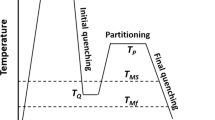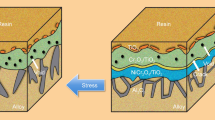Abstract
The hydrogen embrittlement (HE) characteristics of Fe–0.33C–1.2Mn–xNb–xMo steels were investigated experimentally using various samples with differing microstructural characteristics. HE in steels was affected by hydrogen trapping sites: ε-carbide-based, Nb-based, and Mo-based precipitates, which were effective at enhancing HE resistance. In contrast, the prior austenite (γ) grain boundary within steel could act as hydrogen trapping sites and accelerate HE. In addition, hydrogen trapping occurred around the crack, leading to an acceleration of crack growth rate. There are various trapping sites in the steels with negative and positive effects on HE. The extent of the HE was clarified via tensile strength and resistance of delayed failure. Furthermore, the HE characteristics were analyzed using the samples with different quantity of hydrogen charged with two different methods. Based upon the above work, high HE resistance of the steel was proposed as Fe–0.33C–1.2Mn–0.05Nb–0.5Mo steels after a bake-hardening process at 170 °C for 20 min.













Similar content being viewed by others
References
Chan SLI, Charles JA (1986) Effect of carbon content on hydrogen occlusivity and embrittlement of ferrite-pearlite steels. Mater Sci Technol 2:956–962
Chen Y-S, Lu H, Liang J, Rosenthal A, Liu H, Sneddon G, McCarroll I, Zhao Z, Li W, Guo A, Cairney JM (2020) Observation of hydrogen trapping at dislocations, grain boundaries, and precipitates. Science 367:171–175
Choo WY, Lee JY (1982a) Hydrogen trapping phenomena in carbon steel. J Mater Sci 17:1930–1938
Choo WY, Lee JY (1982b) Thermal analysis of trapped hydrogen in pure iron. Metall Trans A 13A:135–140
Depover T, Verbeken K (2016) Hydrogen trapping and hydrogen induced mechanical degradation in lab cast Fe–C–Cr alloys. Mater Sci Eng A 669:134–149
Depover T, Monbaliu O, Wallaert E, Verbeken K (2015) Effect of Ti, Mo and Cr based precipitates on the hydrogen trapping and embrittlement of Fe–C–XQ&T alloys. J Hydrog Energy 40:16977–16984
Enos DG, Scully JR (2002) A critical-strain criterion for hydrogen embrittlement of cold-drawn, ultrafine pearlitic steel. Metall Mater Trans A 33A:1151–1166
Jang JH, Heo Y-U, Lee C-H, Bhadeshia HKDH, Suh D-W (2013) Interphase precipitation in Ti–Nb and Ti–Nb–Mo bearing steel. Mater Sci Technol 29:309–313
Komazaki S, Koyama A, Misawa T (2002) Effect of morphology of copper precipitation particles on hydrogen embrittlement behavior in Cu-added ultra low carbon steel. Mater Trans 43:2213–2218
Li S, Akiyama E, Yuuji K, Tsuzaki K, Uno N, Zhang B (2010) Hydrogen embrittlement property of a 1700-MPa-class ultrahigh-strength tempered martensitic steel. Sci Technol Adv Mater 11:025005
Okayasu M, Motojima J (2020) Microstructure-dependent hydrogen diffusion and trapping in high-tensile steel. Mater Sci Eng A 790:139418
Okayasu M, Yang L (2019) Influence of microstructure on the mechanical properties and hydrogen embrittlement characteristics of 1,800 MPa grade hot-stamped 22MnB5 steel. J Mater Sci 54:5061–5073
Okayasu M, Wu S, Noda K, Lin D-Y, Yang S-M (2016) Mechanical properties of austenitic stainless steel with high niobium contents. Mater Sci Technol 32:1382–1394
Okayasu M, Sato M, Ishida D, Senuma T (2020) The effect of precipitations (NbC and carbide) in Fe–C–Mn–xNb steels on hydrogen embrittlement characteristics. Mater Sci Eng A 791:139598
Shiqi Z, Endian F, Jifang W, Jing L, Yunhua H, Xiaogang L (2018) Effect of Nb on the hydrogen-induced cracking of high-strength low-alloy steel. Corros Sci 139:83–96
Tabuchi M, Kubo K, Yagi K (1991) Effect of specimen size on creep crack growth rate using ultra-large CT specimens for 1Cr–Mo–V steel. Eng Fract Mech 40:31l–321
West AJ, Louthan MR Jr (1979) Dislocation transport and hydrogen embrittlement. Metall Trans A 20:1675–1682
Woodtli J, Kieselbach R (2000) Damage due to hydrogen embrittlement and stress corrosion cracking. Eng Fail Anal 7:427–450
Yamasaki S, Takahashi T (1997) Evaluation method of delayed fracture property of high strength steels. Tetsu-to-Hagane 83:454–459
Zhu X, Li W, Hsu TY, Zhou S, Wang L, Jin X (2015) Improved resistance to hydrogen embrittlement in a high-strength steel by quenching–partitioning–tempering treatment. Scr Mater 97:21–24
Acknowledgements
This research was carried out as a part of a project of the Commission Business Future Exploitation Research Program administered by the New Energy and Industrial Technology Development Organization (NEDO), Japan.
Author information
Authors and Affiliations
Corresponding author
Ethics declarations
Conflict of interest
The authors declare no conflict of interest.
Additional information
Publisher's Note
Springer Nature remains neutral with regard to jurisdictional claims in published maps and institutional affiliations.
Rights and permissions
About this article
Cite this article
Okayasu, M., Arai, R. & Senuma, T. The effects of the microstructural characteristics of Fe–0.33C–1.2Mn–xNb–xMo steels on hydrogen embrittlement fracture. Int J Fract 231, 257–274 (2021). https://doi.org/10.1007/s10704-021-00586-z
Received:
Accepted:
Published:
Issue Date:
DOI: https://doi.org/10.1007/s10704-021-00586-z




